Keeping a cushion of space around you
The best protection you have as a motorcycle or moped driver is distance between you and other drivers. Distance gives you time to react to trouble and find some place to move if necessary.
Always leave a cushion of space around your vehicle to let other drivers see you and to avoid a collision. Keep alert for all other traffic, including vehicles in front, behind, coming toward you and approaching from the side, as well as those you are passing and any that are passing you.
It is important to remember that motorcycles and mopeds, because they weigh less than most other vehicles on the road, are able to stop and accelerate faster than other vehicles. Keep in mind when deciding how much space to leave around you that other drivers may need much more space to stop than you do.
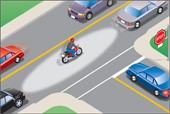
Distance in front
Always keep at least a two-second distance behind the vehicle in front of you. This gives you time to react if something happens ahead. It also gives you a better view of things in the road, such as potholes, slippery spots, chunks of tire tread or debris. If conditions are less than ideal, such as in bad weather, leave even more space. To give yourself at least a two-second space, follow these steps:
- Pick a marker on the road ahead, such as a road sign or hydro pole.
- When the rear of the vehicle ahead passes the marker, count “one thousand and one, one thousand and two.”
- When you reach the marker, stop counting. If you reach the marker before you count “one thousand and two,” you are following too closely.
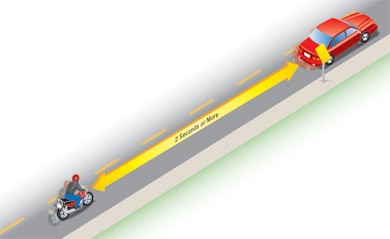
When you stop behind another vehicle, leave enough space to pull out and pass without having to back up about one motorcycle length. If the vehicle in front is large, leave more space. Leaving this space protects you in three ways: it lets you pull around the vehicle in front if it stalls; it helps prevent you from being pushed into the vehicle ahead if you are hit from behind; and it reduces the risk of collision if the vehicle ahead rolls backward or backs up.
Distance to the side
On a motorcycle or moped, you have the ability to change your position within the lane to increase your distance from other vehicles. You should do this as traffic conditions change.
Try to keep a space on both sides of your vehicle. Do not drive beside other vehicles if you can avoid it. A vehicle in the next lane could move into your lane without warning. Vehicles in the next lane also block your escape if you run into danger in your lane. Drop back or speed up until you find a place that is clear on both sides. Avoid driving in other drivers’ blind spots.
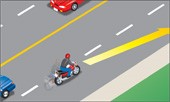
The following are some of the conditions that require changes in lane position:
- Passing vehicles: When you are being passed by an oncoming vehicle or from behind, move toward the centre of the lane. Avoid being closer to a passing vehicle than you have to be; a slight mistake by either driver could cause a sideswipe.
- Parked vehicles: By staying to the left side of the lane, you can avoid the dangers of opening doors, drivers getting out of vehicles or people stepping from between vehicles.
- Vehicles pulling out: When pulling out into traffic, other drivers often take a quick look behind them and fail to see a motorcycle or moped. Vehicles making U-turns are a particular danger. If you see a vehicle pulling out, approach with caution.
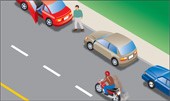
Distance behind
Many drivers complain about “tailgaters” — people who follow others too closely. If someone is following you too closely, change lanes and let the tailgater pass. If a driver still follows you too closely, increase the distance between you and the vehicle ahead. This gives you and the tailgater more time to react in an emergency. Then, when the way is clear to pass safely, slow down so the tailgater can pass.
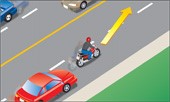
Sharing the road with large vehicles
It is very important to know how to safely share the road with large vehicles such as tractor-trailers and buses. Keep the following factors in mind:
Blind spots
Large vehicles have large blind spots on both sides. Avoid following too closely behind a large vehicle. Not only does it block your vision, but the driver of the large vehicle will not be able to see you back there. If the vehicle has to stop suddenly, you might crash into it. Remember that, if you can’t see the driver’s face in his or her side-view mirror, the driver probably can’t see you.
Stopping distance
Many drivers do not realize that large vehicles require a much longer distance to stop than smaller vehicles. When passing a large vehicle, do not cut in front too closely. Not only is it discourteous, it is dangerous because it reduces the space cushion the large vehicle needs in order to stop safely if the need arises. When you are passing a large vehicle, make allowances for this longer stopping distance.
Wide turns
When making a right turn, a large vehicle may need to first swing wide to the left and then back around to the right in order to avoid hitting the right curb. If a large vehicle in front of you is making a right turn, do not move up into the space that opens up in the right lane; you are putting yourself into a very dangerous position. Once the front of the large vehicle has cleared the corner, the rest will move partially back into the right lane. If you are in that lane, your vehicle will be squeezed between the large vehicle and the curb. Instead, stay well back until the truck has completely cleared the lane. This situation can also occur on expressway off-ramps that have two left-turning lanes. Do not drive up into the left lane when a large vehicle is making a left turn in front of you. Stay well back until the truck has cleared the turn, or else you may get squeezed between the truck and the curb.
Rolling back
Leave plenty of room when you are stopped behind a large vehicle. When the driver of a large vehicle releases the brakes after being stopped, the large vehicle may roll back.
Spray
In bad weather, large vehicles are capable of spraying up large amounts of mud, snow, and debris, which could hit your face shield and block your vision, or even worse, cause you to lose control of your vehicle. Stay well back from large vehicles in bad weather.
Turbulence
Passing a large vehicle on a motorcycle or moped is difficult and can be dangerous. Due to various factors such as air pressure and airflow, a large vehicle can create heavy turbulence that can seriously affect your ability to control your vehicle when you are passing the larger one. If you must pass a large vehicle, try to relax and work with the air turbulence. After you pass through the first blast of turbulent air coming off the back of the truck, you will feel a stream of air either pulling you toward the truck or pushing you away from it, depending on wind direction. Lean away from the truck if the wind is pulling you toward it, or lean toward the truck if you are being pushed away. More turbulence will be waiting for you coming off the front of the truck. Lean into this wind as you pass in front of the truck.
Sharing the road with municipal buses
Many municipal roadways have special indented stopping areas for municipal buses, called bus bays, where passengers can get on and off in safety. There are three types of bus bays:
- Mid-block indented bay
- Indentations immediately before and after intersections
- Bus-stop areas between two designated parking areas
When a bus in a bus bay begins flashing its left-turn signals, indicating that it is ready to leave the bus bay, and you are approaching in the lane adjacent to the bus bay, you must allow the bus to re-enter traffic. Yielding the right-of-way to buses in this situation is the law.
- Mid-block indented bays
- An indentation before an intersection
- An indentation after an intersection
- Bus stops between legally parked cars

Summary
By the end of this section, you should know:
- The importance of maintaining space between yourself and other road users
- How to measure following distance while driving
- Situations where you can change your position within your driving lane to increase the distance between yourself and other road users
- How to deal with tailgaters
- Special considerations when sharing the road with larger vehicles